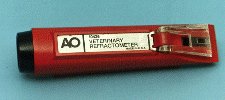|
Specific Gravity of Urine
 Urine specific gravity (USG) and osmolality are measures of the solute concentration in urine and are used to assess the ability of the renal tubules to concentrate or dilute the glomerular filtrate.
Urine specific gravity (USG) and osmolality are measures of the solute concentration in urine and are used to assess the ability of the renal tubules to concentrate or dilute the glomerular filtrate.
The diagram and notes below detail how the kidney concentrates urine.
| Schematic representation of the passive urinary concentrating mechanism |
 |
The thin ascending limb in the inner medulla and the thick ascending limb in the outer medulla and first part of the distal tubule are permeable to NaCl but impermeable to water (as indicated by the thickened lining).
1. In the water-impermeable thick ascending limb, absorption of NaCl via the NaK2Cl carrier renders the tubular fluid dilute and the outer medullary interstitium hyperosmotic. Urea is poorly absorbed and is retained in the tubular fluid.
2. Water is resorbed down the osmotic gradient established in the outer medulla in the last part of the distal tubule and collecting ducts (the latter under the influence of ADH).
3. In the inner medulla, water and urea are absorbed (under the action of ADH) from the collecting duct, contributing substantially to the medullary interstitial osmotic gradient.
4. This high concentration of urea osmotically extracts water from the solute-impermeable descending limb, thus concentrating NaCl in the descending-limb fluid.
5. When this NaCl-rich fluid enters the NaCl-permeable (water-impermeable) thin ascending limb, NaCl is absorbed passively along its concentration gradient, producing a relatively dilute renal tubule fluid.
Adapted from: Schrier: Renal and Electrolyte Disorders. |
Urine specific gravity is a measurement of the density of urine compared to pure water. For routine clinical purposes, USG is
determined using a refractometer (refractive index generally correlates well with USG). The USG is influenced by the number of molecules in urine, as well as their molecular weight and size, therefore it only approximates solute concentration. It is also affected by temperature, with urine density decreasing with increasing temperatures. The presence of large amounts of protein and glucose will alter the USG and should be considered when interpreting USG results. The following substances will increase the USG by 0.001 units.
| Substance | Value |
| NaCl | 0.15 g |
| Urea | 0.36 g |
| Glucose | 0.27 g |
| Albumin | 0.4 g |
Urine osmolality is directly related to the number of particles in solution and is unaffected by molecular weight and size. Osmolality can be measured by freezing point depression (technique used at Cornell University) and changes in vapor pressure. Urine osmolality can be approximated from the USG, by multiplying the last 2 digits of the USG by 36.
Knowledge of urinary solute concentration is essential for proper interpretation of BUN and serum
creatinine, which are indicators of glomerular filtration rate. The USG is very useful for identifying the cause of azotemia.
The interpretation of several urine chemical
parameters also is influenced by the specific gravity of the specimen. Why does this make sense?
In addition, urinary constituents (erythrocytes, leukocytes and casts) can lyse in dilute urine (USG < 1.008), affecting interpretation of the urine sediment results.
| Species | Possible range | Usual range | "Adequate" |
|---|
| Canine | 1.001-1.065 | 1.015-1.045 | >1.030 |
| Feline | 1.001-1.080 | 1.035-1.060 | >1.035 |
| Large Animals | 1.001-1.040 | 1.015-1.030 | >1.025 |
Last Updated: Friday, January 15th 1999
|
 Urine specific gravity (USG) and osmolality are measures of the solute concentration in urine and are used to assess the ability of the renal tubules to concentrate or dilute the glomerular filtrate.
Urine specific gravity (USG) and osmolality are measures of the solute concentration in urine and are used to assess the ability of the renal tubules to concentrate or dilute the glomerular filtrate.
